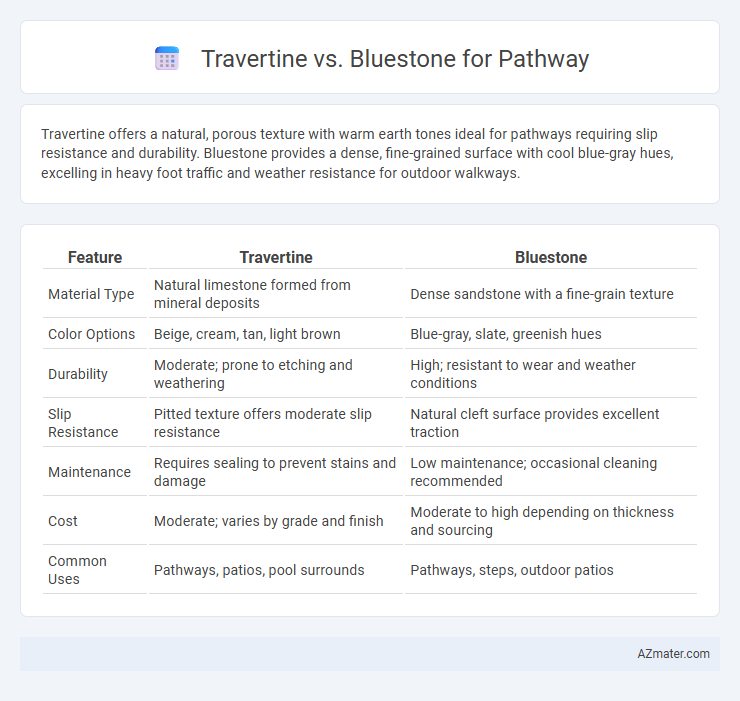Travertine offers a natural, porous texture with warm earth tones ideal for pathways requiring slip resistance and durability. Bluestone provides a dense, fine-grained surface with cool blue-gray hues, excelling in heavy foot traffic and weather resistance for outdoor walkways.
Table of Comparison
| Feature | Travertine | Bluestone |
|---|---|---|
| Material Type | Natural limestone formed from mineral deposits | Dense sandstone with a fine-grain texture |
| Color Options | Beige, cream, tan, light brown | Blue-gray, slate, greenish hues |
| Durability | Moderate; prone to etching and weathering | High; resistant to wear and weather conditions |
| Slip Resistance | Pitted texture offers moderate slip resistance | Natural cleft surface provides excellent traction |
| Maintenance | Requires sealing to prevent stains and damage | Low maintenance; occasional cleaning recommended |
| Cost | Moderate; varies by grade and finish | Moderate to high depending on thickness and sourcing |
| Common Uses | Pathways, patios, pool surrounds | Pathways, steps, outdoor patios |
Introduction to Travertine and Bluestone Pathways
Travertine pathways feature natural limestone with a porous texture and earth-toned hues, offering durability and a slip-resistant surface ideal for outdoor walkways. Bluestone pathways, made from dense sandstone, provide a sleek, smooth finish with a rich blue-gray color, known for weather resistance and elegant aesthetics. Both materials enhance landscape design but differ in texture, color, and maintenance requirements.
Key Differences Between Travertine and Bluestone
Travertine is a porous, sedimentary rock characterized by its smooth texture and warm beige tones, whereas Bluestone is a dense, durable sandstone known for its rich blue-gray color and fine-grained surface. Travertine pathways offer a natural, classic aesthetic with good heat resistance, making them ideal for sunny climates, while Bluestone provides superior slip resistance and strength, suitable for high-traffic or wet environments. Maintenance differs as Travertine may require periodic sealing to prevent staining and erosion, whereas Bluestone's inherent toughness typically demands less frequent upkeep.
Aesthetic Appeal: Color and Texture Comparison
Travertine offers warm, earthy tones ranging from creamy beige to rich caramel with a porous, textured surface that adds natural charm to pathways. Bluestone features cool blue-gray hues with a smooth, fine-grained texture providing a sleek, modern appearance ideal for contemporary landscape designs. Both stones bring distinct aesthetic qualities, making travertine perfect for rustic or Mediterranean styles and bluestone suited to minimalist or urban pathways.
Durability and Longevity in Outdoor Pathways
Travertine exhibits excellent durability for outdoor pathways, maintaining its strength and appearance despite exposure to weather elements, while its porous nature requires proper sealing to prevent moisture damage and prolong longevity. Bluestone offers superior resistance to wear and weathering due to its dense composition and low porosity, making it a long-lasting choice with minimal maintenance for outdoor environments. Both materials provide durable solutions, but Bluestone generally surpasses Travertine in longevity under harsh outdoor conditions.
Slip Resistance and Safety Features
Travertine offers excellent slip resistance due to its naturally porous surface, making it a safer choice for pathways, especially in wet conditions. Bluestone features a fine-grained texture that provides moderate slip resistance but can become slippery when polished or wet. Prioritizing travertine enhances pathway safety, while bluestone requires careful finishing and maintenance to maintain adequate traction.
Maintenance Requirements for Each Stone
Travertine requires regular sealing to prevent staining and erosion caused by water and outdoor elements, with periodic cleaning using mild detergents to maintain its polished surface. Bluestone demands less frequent sealing but benefits from routine sweeping and occasional pressure washing to remove dirt and debris, maintaining its natural slip-resistant texture. Both stones need prompt attention to spills and organic growth to extend their longevity and aesthetic appeal on pathways.
Cost Comparison: Travertine vs Bluestone
Travertine pathways generally cost between $15 and $30 per square foot, reflecting its affordability and wide availability, while bluestone ranges from $20 to $40 per square foot due to its denser composition and premium aesthetic. Installation expenses for travertine tend to be lower because it is easier to cut and handle, whereas bluestone requires specialized labor that drives up overall costs. Long-term maintenance of travertine is typically less costly, but bluestone's durability can offset initial higher costs by reducing repair frequency over time.
Climate Suitability and Weather Performance
Travertine exhibits excellent durability in warm, dry climates due to its porous nature, providing natural slip resistance and cooling properties ideal for pathways in Mediterranean or desert regions. Bluestone offers superior frost resistance and withstands freeze-thaw cycles effectively, making it suitable for pathways in colder, wetter climates with frequent rainfall or snow. Both stones provide distinct advantages: travertine excels in hot environments, while bluestone ensures longevity and safety in cooler, moisture-prone conditions.
Installation Process and Challenges
Travertine pathways require careful sealing and precise leveling during installation to prevent water infiltration and uneven surfaces, while bluestone demands a stable, well-prepared base due to its heavier weight and irregular shapes. Cutting travertine is easier with standard wet saws, but bluestone often needs specialized tools for shaping, increasing labor complexity. Both materials pose challenges in ensuring proper drainage and consistent spacing to avoid shifting and cracking over time.
Environmental Impact and Sustainability Considerations
Travertine is a natural limestone formed by mineral deposits from hot springs, making it a renewable resource with low carbon emissions during quarrying, and it is highly durable with minimal maintenance requirements. Bluestone, a dense sedimentary rock primarily composed of sandstone, tends to have a higher environmental cost due to more intensive extraction processes and transportation impacts, but it is also durable and long-lasting for pathways. Both materials offer sustainable benefits when sourced locally and installed using eco-friendly practices, yet travertine generally boasts a lower environmental footprint due to its lighter quarrying impact and natural formation.

Infographic: Travertine vs Bluestone for Pathway
 azmater.com
azmater.com